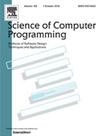Model checking with memoisation for fast overtaking planning
IF 1.4
4区 计算机科学
Q3 COMPUTER SCIENCE, SOFTWARE ENGINEERING
引用次数: 0
Abstract
Fast and reliable trajectory planning is a key requirement of autonomous vehicles. In this paper we introduce a novel technique for planning the route of an autonomous vehicle on a straight, traffic-heavy rural road using the SPIN model checker. We show how we can combine SPIN's ability to identify paths violating temporal properties with sensor information from a 3D Unity simulation of an autonomous vehicle, to plan and perform consecutive overtaking manoeuvres. This involves discretising the sensory information and combining multiple sequential SPIN models with a Linear-time Temporal Logic specification to generate an error path. This path provides the autonomous vehicle with an action plan. The entire process is fast (using no precomputed data) and the action plan is tailored for individual scenarios. Our experiments demonstrate that the simulated autonomous vehicle implementing our approach can drive a median of 37 km and overtake a median of 187 vehicles before experiencing a collision - which is usually caused by inaccuracies in the sensory system. We also describe a memoisation approach which helps to mitigate one of the drawbacks of our approach - the cost of model compilation. Our novel approach demonstrates a potentially powerful future tool for efficient trajectory planning for autonomous vehicles.
模型检查与记忆,快速超车计划
快速、可靠的轨迹规划是自动驾驶汽车的关键要求。在本文中,我们介绍了一种新的技术,用于规划自动驾驶汽车在一条笔直的、交通繁忙的农村道路上的路线,使用SPIN模型检查器。我们展示了如何将SPIN识别违反时间属性的路径的能力与自动驾驶汽车3D Unity模拟的传感器信息相结合,以规划和执行连续超车操作。这涉及到将感官信息离散化,并将多个序列自旋模型与线性时间时序逻辑规范相结合,以生成错误路径。这条路径为自动驾驶汽车提供了一个行动计划。整个过程是快速的(不使用预先计算的数据),行动计划是针对个别情况量身定制的。我们的实验表明,采用我们方法的模拟自动驾驶汽车在经历碰撞之前可以行驶中位数37公里,并超过中位数187辆汽车,而碰撞通常是由传感系统的不准确引起的。我们还描述了一种记忆方法,它有助于减轻我们方法的一个缺点——模型编译的成本。我们的新方法展示了一个潜在的强大的未来工具,用于自动驾驶汽车的有效轨迹规划。
本文章由计算机程序翻译,如有差异,请以英文原文为准。
求助全文
约1分钟内获得全文
求助全文
来源期刊

Science of Computer Programming
工程技术-计算机:软件工程
CiteScore
3.80
自引率
0.00%
发文量
76
审稿时长
67 days
期刊介绍:
Science of Computer Programming is dedicated to the distribution of research results in the areas of software systems development, use and maintenance, including the software aspects of hardware design.
The journal has a wide scope ranging from the many facets of methodological foundations to the details of technical issues andthe aspects of industrial practice.
The subjects of interest to SCP cover the entire spectrum of methods for the entire life cycle of software systems, including
• Requirements, specification, design, validation, verification, coding, testing, maintenance, metrics and renovation of software;
• Design, implementation and evaluation of programming languages;
• Programming environments, development tools, visualisation and animation;
• Management of the development process;
• Human factors in software, software for social interaction, software for social computing;
• Cyber physical systems, and software for the interaction between the physical and the machine;
• Software aspects of infrastructure services, system administration, and network management.
 求助内容:
求助内容: 应助结果提醒方式:
应助结果提醒方式:


